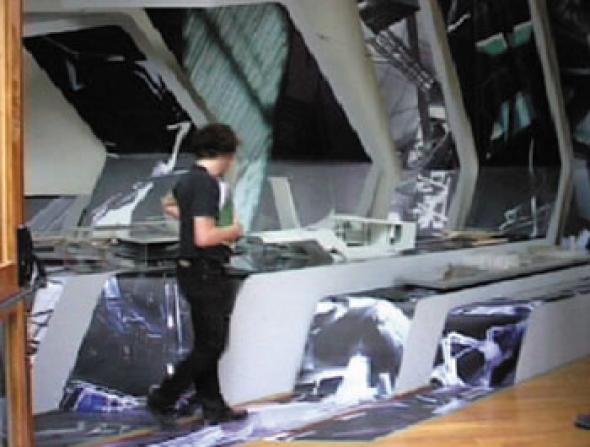Algorithms in the Sky
Lucy Bullivant on the Venice Architecture Biennale, where yogic flyers vied with commercial comfort zones to sketch out an ethical architecture
The Venice Architecture Biennale is an international architectural ‘culturefest’ on an unrivalled scale, generally taking place each alternate year at the Giardini di Castello when the longer established Venice art biennale isn’t. The Biennale often overlaps with the Venice Film Festival and, like a film, is marshalled by a director who sets the theme, controls the ground troupes, and makes a big creative statement.
Last time around Hans Hollein, renowned architect of museums and shopping centres, invited entrants to consider the notion that the architect was now a seismograph registering cultural trends. A grande bouffe of creative responses resulted, culminating in a debate on the role of the media in the world of architecture, staged by Domus magazine. The illustrious debaters, architect Zaha Hadid among them (currently the subject of a major exhibition at the ICA, her dynamically sinuous urban interventions also rise up like a bed of majestic grey sea serpents in the back room of this year’s British pavilion), attested to the huge growth in media coverage architecture has enjoyed in recent years. However, as one of them pointed out at the time, if architecture itself acknowledges a seismographic role only to be interpreted by another seismograph (the media), don’t the two cancel each other out?
This year’s theme was ‘Less aesthetics, more ethics’, and was set by Italian architect Massimiliano Fuksas, who seemed to be addressing exhibition makers as much as architects. In conversation, he claimed it was “most important to find a new relationship with the public – there is a polarity between high standard architectural work right now and the interests of its audience, and someone has to move.” Making a quick mention of the new peace centre Shimon Perez has invited him to design, he emphasised that “the exhibition is part of the debate on the new, transforming social and urban context – and architects’ commitments as intellectuals,” adding: “There are no value judgements here in the displays about quality.”
The massive variety of responses on exhibition testified to the confusion that the loss of reference points Fuksas describes has engendered. The same could be said of Fuksas’s own trickery – a 400 metre long video wall running the length of the Corderie section of the complex featuring a panoramic mix of global capitalism’s cultural signifiers and ciphers of technology gone bad. With a video image of a train hurtling along the length of the display every few minutes, one wondered whether architects were going to be travelling on it as observant passengers or driving it, blindly impervious to their global landscape.
Richard Rogers, exhibiting an enormous funnel-shaped wooden model of the new Welsh Assembly, defined ethical architecture as “sustainable, quieter, more comfortable, beautiful and stimulating”. Japan’s pavilion was bedecked with artificial daisies, a bed of white stones and bandaged trees. The French apparently tried to counter this kind of oblique aesthetic statement by covering their pavilion with rhetorical texts under the banner ‘In the Shadow of Ethics’, a semantic quagmire which ended rhetorically with the phrase ‘ethics masks the emptiness of politics’.
The Dutch did their damnedest to make you feel comfortable, lulling you into a state of relaxation with their private/public, minimally attired salon where bottled water, a sofa and adjustable personal TVs were on offer (a manual outlined ways in which the room might be used while psychological questionnaires checked your motives for doing so). Designed by NL Architects, this pavilion embraced commercialism and human comfort as a way of urging architects to live in the real world.
Japanese star architect Arata Isozaki invited a live performance of ‘yogic flying’ on cushions in and around his displays. His plea for a transcendental architecture was poignant, but not as charming as the Irish, who used peat briquettes to provide a commentary on landscape. There again, Austria was blessed with neither charm nor irony, presenting its site as an “area of tolerance for peace and freedom of art against xenophobia” (sic). Somewhere, amidst its liberalist arguments, could be found one small picture of an anti-Haider demonstration.
None of these harnessed the medium of architecture to its message quite like the US pavilion did, where a technically adroit display by Greg Lynn and Hani Rashid – arguably two of America’s finest young architects and theoreticians – transformed the space into a research laboratory for the investigation and production of new architectural schemes. New technology and its application to contemporary housing was the key theme, encouraging visitors to treat advanced technologies as a defining factor, rather than a byproduct, of the complexities of contemporary life. (If city structures are seen as process-oriented, fluid environments, then an appropriate architecture is one that is simultaneously physical, virtual and dynamic in its very condition.)
Like Kas Oosterhuis’s interactive ‘trans-ports’ display with its intended permanent exchange between physical and Internet versions, deCOI’s 3D screen with a computer-controlled, reconfigurable surface, and the work of NOX, Asymptote, FOB and Project.co.jp, the Rashid/Lynn presence underlined the gradual but unmistakable move towards a new type of architectural practice. The assembled teams of multi-disciplinary, technologically advanced practitioners are not just space manipulators – they are organisers of integrated communicative and creative processes. Maybe they also know what Fuksas means when talks about having an “understanding of the algorithm of the system, because you have to realise we can’t use the same models as in the past’.
Lucy Bullivant <lucyb AT dircon.co.uk>
Mute Books Orders
For Mute Books distribution contact Anagram Books
contact@anagrambooks.com
For online purchases visit anagrambooks.com








